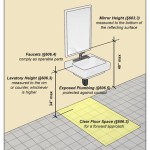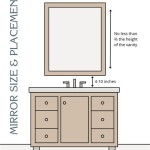How Much Does it Cost to Remove a Bathroom Vanity? A Comprehensive Guide
Removing a bathroom vanity is a project many homeowners undertake to renovate their bathrooms, either to install a new vanity or change the overall layout. Understanding the costs associated with this task is essential for budgeting and planning. The total expense can fluctuate significantly based on several factors, including whether the homeowner performs the removal themselves or hires professionals, the complexity of the job, and the geographical location.
This article delves into the various aspects of the cost of removing a bathroom vanity. It will cover DIY approaches, professional services, potential hidden costs, and strategies for managing expenses effectively. Understanding these elements allows homeowners to make informed decisions and anticipate the financial implications of their bathroom renovation projects.
DIY Vanity Removal: Cost Breakdown
Opting for a do-it-yourself approach to vanity removal can significantly reduce costs, primarily by eliminating labor expenses. However, even with a DIY project, certain expenses are unavoidable. These can include the cost of tools, safety equipment, and disposal fees.
Tools and Equipment: While many homeowners already possess basic tools like screwdrivers, pliers, and wrenches, specific tasks might require specialized tools. These could include a pipe wrench for disconnecting plumbing, a reciprocating saw for cutting through stubborn caulking or adhesive, and a stud finder for locating wall studs. Renting tools can be a cost-effective alternative to purchasing them outright, especially for infrequent use. Expect to spend between $20 and $100 on tool rentals or purchases, depending on the complexity of the job and the tools already available.
Safety Gear: Safety should always be a priority when undertaking any home improvement project. Essential safety gear for vanity removal includes safety glasses to protect the eyes from debris, work gloves to protect the hands, and a dust mask to prevent inhalation of dust and mold spores. These items are relatively inexpensive, typically costing between $10 and $30.
Disposal Fees: Disposing of the old vanity can involve fees, depending on local regulations and the chosen disposal method. Simply tossing the vanity into the regular trash might be prohibited. Options include hauling it to a local landfill, which may charge a disposal fee based on weight or volume, or hiring a junk removal service. Landfill fees can range from $20 to $50, while junk removal services can cost between $100 and $300, depending on the size and weight of the vanity and the distance to the disposal facility.
Unexpected Repairs: During the removal process, unforeseen issues might arise, such as water damage hidden behind the vanity or damaged drywall. Addressing these problems will add to the overall cost. Patching drywall can require materials like drywall compound, sandpaper, and paint, costing between $20 and $50. More extensive water damage might necessitate professional remediation, which can significantly increase expenses.
Time Investment: While not a direct monetary cost, the time invested in a DIY project should be considered. Vanity removal can take anywhere from a few hours to a full day, depending on the homeowner's skill level and the complexity of the installation. This time could be spent on other activities, so it's important to factor this opportunity cost into the decision-making process.
Professional Vanity Removal: Cost Factors
Hiring professionals to remove a bathroom vanity offers the advantage of expertise and efficiency, but it also comes with a higher price tag. The cost of professional services is influenced by various factors, including labor rates, the complexity of the job, and any additional services required.
Labor Costs: Labor costs represent a significant portion of the overall expense. Plumbers and general contractors typically charge hourly rates, which can vary depending on location and experience. Expect to pay between $50 and $150 per hour for professional labor. The total labor cost will depend on the estimated time required to complete the job. A simple vanity removal might take a few hours, while a more complex project involving plumbing modifications or dealing with unforeseen issues could take longer.
Complexity of the Job: The complexity of the vanity removal process significantly impacts the cost. Factors that can increase complexity include:
- Plumbing: Disconnecting and reconnecting plumbing lines requires skill and expertise. If the plumbing is old or corroded, additional repairs or replacements may be necessary, adding to the cost.
- Electrical Wiring: If the vanity has integrated lighting or electrical outlets, disconnecting and reconnecting the wiring safely is crucial. This may require the services of a qualified electrician.
- Difficult Access: If the bathroom is small or difficult to access, it can increase the time and effort required to remove the vanity, thereby increasing labor costs.
- Custom Installations: Custom-built vanities or vanities that are tightly integrated into the bathroom design can be more challenging to remove than standard vanities.
Additional Services: In addition to the basic removal of the vanity, homeowners may require additional services, such as:
- Disposal: Professionals can handle the disposal of the old vanity, but this service typically incurs an additional fee.
- Drywall Repair: If the removal process damages the drywall, the professionals can repair it, but this will add to the overall cost.
- Painting: After the vanity is removed and the drywall is repaired, painting the area may be necessary. This can be done by the professionals or by the homeowner.
Permits: In some jurisdictions, a permit may be required to remove or replace a bathroom vanity, especially if plumbing or electrical work is involved. Obtaining the necessary permits can add to the overall cost. The cost of permits varies depending on location and the scope of the project, ranging from $50 to $200.
Minimizing Costs and Avoiding Surprises
While certain costs are unavoidable, there are several strategies homeowners can employ to minimize expenses and avoid unexpected surprises during the vanity removal process. Planning and preparation are key to managing costs effectively.
Detailed Planning: Before starting the removal process, carefully assess the project scope and identify any potential challenges. This includes inspecting the plumbing, electrical wiring, and the surrounding area for signs of damage or potential problems. Creating a detailed plan will help prevent costly surprises down the road.
Accurate Measurements: Accurate measurements are crucial for selecting a replacement vanity that fits properly and avoids the need for costly modifications. Measure the available space carefully, taking into account the placement of plumbing lines and electrical outlets.
Multiple Quotes: If hiring professionals, obtain quotes from multiple contractors to compare prices and services. Ensure that the quotes are detailed and include all potential costs, such as labor, materials, disposal fees, and permit costs. Checking references and reading online reviews can help ensure that you are hiring a reputable and reliable contractor.
Salvaging Materials: Consider salvaging materials from the old vanity, such as the countertop, sink, or hardware. These materials can be reused in other projects or sold to recoup some of the costs. However, be mindful of the time and effort required to salvage these materials and ensure that they are in good condition.
Negotiating Prices: Don't be afraid to negotiate prices with contractors or suppliers. Many contractors are willing to negotiate, especially if you are willing to be flexible with scheduling or materials. Suppliers may also offer discounts for bulk purchases or for paying in cash.
Preparedness for Unexpected Issues: It is always wise to set aside a contingency fund to cover unexpected issues that may arise during the removal process. This fund should be approximately 10% to 20% of the total project budget. Having a contingency fund will provide peace of mind and prevent financial stress if unforeseen problems occur.
In conclusion, the cost of removing a bathroom vanity can vary significantly depending on whether the homeowner opts for a DIY approach or hires professionals, the complexity of the job, and the geographical location. By understanding the various cost factors and implementing strategies to minimize expenses, homeowners can effectively manage their budgets and avoid unexpected surprises during their bathroom renovation projects. Careful planning, accurate measurements, and obtaining multiple quotes are essential steps in ensuring a successful and cost-effective vanity removal.

Bathroom Vanity Installation Cost 2024 Average S

How To Remove A Bathroom Vanity Budget Dumpster

How Much Does It Cost To Remove A Bathroom Vanity Upgradedhome Com

2024 Cost To Replace Bathroom Countertop A Guide

How To Remove Bathroom Vanity Cabinet Step By Guide

How To Remove A Bathroom Vanity Remodel

How To Remove Your Bathroom Sink And Vanity Dumpsters Com

How To Remove A Bathroom Vanity

How Much Does It Cost To Install A Bathroom Vanity 2024 Bob Vila

How Much Does Bathroom Vanity Replacement Cost 2024







